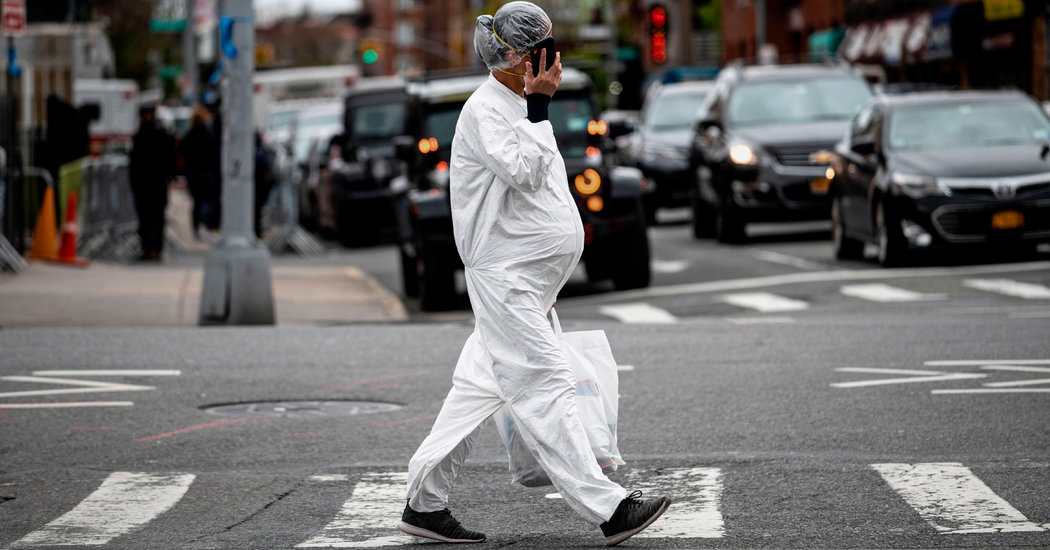“Two of us enter the hospital, three of us leave, and you tell us how it’s done safely.”
This was the birth plan of one of my patients. Not from now, during the Covid-19 epidemic, but in the good old days of 2018. I have quoted this to my patients frequently since then, but no more so than in the past month.
Anxiety about having a baby in New York City, and about whether it would be better to leave the city, spiked when several city hospitals barred partners from attending deliveries. With news of asymptomatic women in labor testing positive in the hospital and a Covid-19 patient meeting her baby via video chat from the neonatal intensive-care unit, the feeling grew that having a baby in a New York City hospital was not just less safe than it used to be, but patently unsafe.
So let me add my perspective as an obstetrician delivering in a hospital that like every other in the city is filled with Covid-19 patients. I’m not a public health official or a hospital administrator. I can’t comment on the nuances of what’s happening all across the city. I am one doctor, in one practice, with a knowledge of my patients, my partners and the universe that is my hospital.
And I will say this: If you planned on delivering in a New York City hospital, don’t change your plans.
For every terrifyingly ill pregnant woman featured in a news story, there are beautiful, normal, uncomplicated deliveries taking place, even among infected women. And present at these good and normal moments, there are doctors and midwives, nurses and other staff members, coming to the hospital, staying up through the night, comforting their patients and smiling through it all — even if you can’t tell because of the N95 masks we have on.
I have had many patients decamp to sites outside the city, after calculating that it was safer elsewhere. First of all, such last-minute changes of plans, whether moving outside New York or switching to a home birth, are privileges of a certain class of New Yorker. Many pregnant women are limited, whether by income, insurance status or other circumstances, to stay, often at a specific hospital. So all New York City women need to know what is stable and safe and intrinsically reliable about having a baby here during the pandemic.
There is much more to labor and delivery than the specter of the coronavirus. Giving birth is inherently risky. Hemorrhage, infection, pulmonary embolism, pre-eclampsia, even death are risks pregnant women face and the things for which doctors and midwives are always on the watch. And these risks remain much more likely for pregnant women in New York than the risk of falling seriously ill with Covid-19 while delivering a baby.
To illustrate this, consider the best data we have on Covid-19 in pregnancy for New York City, from Columbia University Medical Center, which show that 1.9 percent of women have symptomatic coronavirus in labor, only a subset of whom have severe disease. And the most recent city Department of Health data show that 2.6 percent of women will suffer life-threatening complications during labor unrelated to Covid-19. With this in mind, having a doctor you trust in a hospital that is equipped for the most common emergencies is key. If you move, will your care be the same as before? Does your hospital have the capacity for emergency C-sections? Is there a blood bank on site, in case you need a transfusion? If your baby suffered a complication, is there a neonatal I.C.U., or would your baby be transferred?
There could also be a paradoxical benefit of being in a hot spot. Hardship breeds expertise, and New York hospitals have become experts not only in treating Covid-19 but also in how to handle the disease during pregnancy.
My hospital was early to mandate masks for all staff members, limit visitors while having partners present during deliveries and adopt universal testing for patients. This has let us operate as close to normal as possible.
More important, New York City hospitals may have braved the recent peak of this disease, weathering the acid test of its ability to keep essential services for labor and delivery running essentially unchanged in the midst of a storm. (Much as we kept things going during a literal storm in our past: Hurricane Sandy in 2012.) This means that we will have a better sense of what to do if this peaks again. It’s unclear when the peaks will happen elsewhere across the country, or how bad they will be. Will smaller areas with fewer hospitals see greater stress on their hospital systems than New York City did?
Recent articles cite the high number of pregnant women who have tested positive for the coronavirus — especially the high proportion of asymptomatic women — and this too is making women afraid. That fear is based on the fallacy of thinking that testing changes the reality of what’s being tested. It only reveals what has been there all along. Universal testing in labor and delivery units will make everyone safer, even if it makes us feel less safe by peeling back the curtain. Knowing who is infected allows staffs to isolate women during labor to minimize risk to other patients and to staff members, to monitor those patients more carefully for symptom onset or disease progression for their own health and to apply different protocols to babies born to mothers with Covid-19 to limit their risk.
So it makes no sense to clamor for universal testing in the community and then recoil from the results when testing is successfully applied in a specific environment. Nor is it right to assume that hospitals outside the city would have fewer infected women in their midst. Until enough testing rolls out universally, nobody knows.
Among other trends, concern about asymptomatic spread at hospitals has led to a surge in women seeking home births, even though home birth is not for everyone. It’s a viable option for low-risk women, when clear criteria for home birth candidacy are followed. But even in the best of circumstances, it comes with certain risks, like the potential need for emergency transfer to a hospital. The complications that come in such an eventuality may be increased right now, because of factors like slower ambulance response times as a result of Covid-19 delaying a needed transfer.
More important, thinking of home birth as a way to mitigate coronavirus exposure risk is problematic. Letting someone into the home who doesn’t adhere to rigorous practices may place a woman at higher risk than being in a hospital. A midwife prominently featured in a recent New York Times article about home births said that wearing a mask “is not part of my belief system.” I shuddered when I read that.
So if we’re going to talk about belief systems, this is what I believe: The process of delivering a child is wonderful but inherently risky. Doctors and midwives who shepherd that process take our responsibility very seriously. That includes an understanding of all the factors involved in safely increasing the members of a family by, the coronavirus being only one of these factors. Women benefit from having doctors and midwives who know them well and have an established relationship with them, in delivery settings that are trusted and tested.
Patients have to make the choice of what is right for them. But a change of plans mid-pregnancy may not be in a woman’s or her baby’s best interest. While this is a world-shaking time, we will take the same care of you as we always have.
So if you choose to stay here with us, we will be here for you.
Spencer W. McClelland is a partner at NY Midtown OB/GYN and a member of the clinical faculty at Lenox Hill Hospital/Northwell Health in Manhattan.
The Times is committed to publishing a diversity of letters to the editor. We’d like to hear what you think about this or any of our articles. Here are some tips. And here’s our email: [email protected].
Follow The New York Times Opinion section on Facebook, Twitter (@NYTopinion) and Instagram.



















